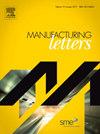Deposition stability and enhanced microhardness of laser shock peened of Ti6Al4V alloy manufactured by high layer thickness laser additive manufacturing
IF 2
Q3 ENGINEERING, MANUFACTURING
引用次数: 0
Abstract
Thin layer thickness is one of the drawbacks of additive manufacturing (AM) leading to longer printing time. Higher layer thickness can address this with a higher tendency of improper deposition, and surface cracks. The current paper implements high-layer thickness laser-directed energy deposition (LDED) AM of Ti6Al4V alloy to investigate deposition stability, surface crack, and microhardness. Laser shock peening (LSP) is also employed to modify microstructures and enhance microhardness. This study provides the details of the surface cracks and effects of LSP on surface modification and hardness of the samples fabricated by the LDED process. Proper deposition with some spatters and surface cracks on as-printed samples were observed. Surface removal of about 0.5 mm eliminated most of the surface cracks. Elongated columnar β grains and Widmanstätten pattern were observed. Plastic deformation and grain refinement due to LSP resulted in enhanced microhardness. Highest increase of 48.12 % in microhardness was observed after LSP was applied to the fabricated samples.
高层厚激光增材制造Ti6Al4V合金激光冲击强化的沉积稳定性及显微硬度的提高
薄层厚度是增材制造(AM)的缺点之一,导致较长的打印时间。较高的层厚可以解决这一问题,但也会增加不适当沉积和表面裂纹的倾向。本论文采用高层厚激光定向能沉积(LDED)增材制造Ti6Al4V合金,研究沉积稳定性、表面裂纹和显微硬度。激光冲击强化(LSP)也被用于改善显微组织和提高显微硬度。本研究提供了表面裂纹的细节,以及LSP对LDED工艺制备的样品表面改性和硬度的影响。在打印样品上观察到适当的沉积,有一些飞溅和表面裂纹。表面去除约0.5 mm消除了大部分表面裂纹。观察到细长柱状β晶粒和Widmanstätten模式。LSP引起的塑性变形和晶粒细化导致了显微硬度的提高。制备的样品经LSP处理后,显微硬度最高提高48.12%。
本文章由计算机程序翻译,如有差异,请以英文原文为准。
求助全文
约1分钟内获得全文
求助全文
来源期刊

Manufacturing Letters
Engineering-Industrial and Manufacturing Engineering
CiteScore
4.20
自引率
5.10%
发文量
192
审稿时长
60 days
 求助内容:
求助内容: 应助结果提醒方式:
应助结果提醒方式:


